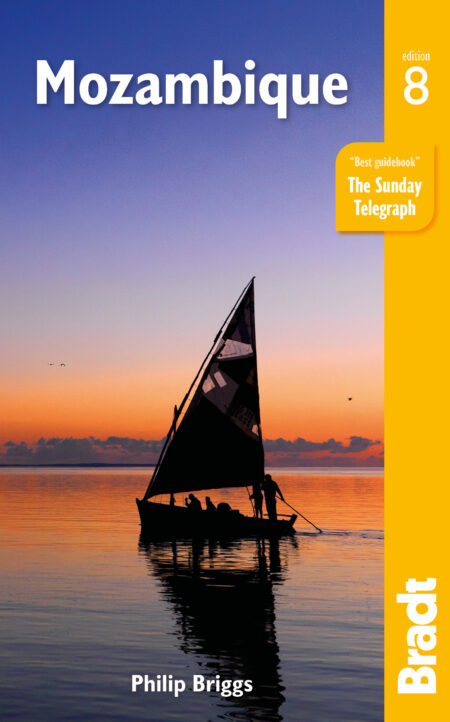The largest urban centre in Mozambique, Maputo is a bustling and attractive port city that has served as the national capital since 1898, when it was known as Lourenço Marques (LM for short). It lies on the Gulf of Maputo (formerly Delagoa Bay) in the far south of Mozambique, within 100km of the South African and Eswatini borders. As such, it often feels more strongly connected to South Africa than to the rest of Mozambique, a circumstance reflected in a popular saying that likens Mozambique to a funnel – all the money flows down south!
From impressive architecture to botanical gardens and bustling markets, Maputo is well worth exploring, and there’s no better way to do it than on foot.
Polana
Start from the Polana Serena, for decades the showpiece of Maputo’s hotels, situated on a rise high above the Bay of Maputo in the quarter of the same name, east of the city centre on Avenida Julius Nyerere. Built in 1922, it was designed by the celebrated English architect Sir Herbert Baker, who also created Cape Town’s iconic Mount Nelson Hotel and the Union Buildings in Pretoria, where Nelson Mandela was inaugurated as President of South Africa in 1994. The Polana survived the revolution in a somewhat run-down condition, but was refurbished in the early 1990s and again in 2002, now restored to its former glory.
Heading south from the Polana, turn off Avenida Julius Nyerere into the first street to the left, Rua Mukumbura, and walk along Avenida Friedrich Engels, which runs high above the coast. This shady road is lined with trees, bougainvillea-draped lookout points and benches, and the view extends over the Clube Naval beyond the Bay of Maputo to the island of Inhaca.
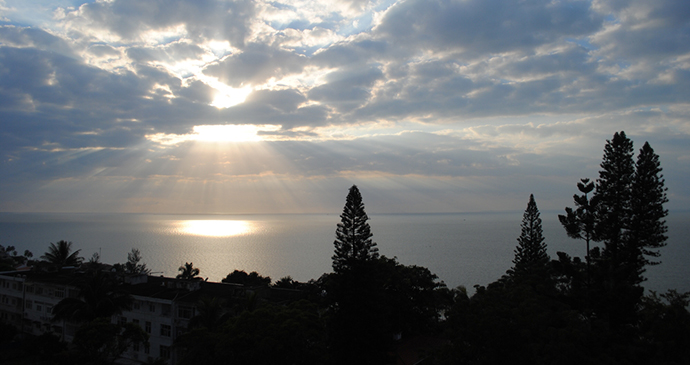
You can walk along Avenida Friedrich Engels almost as far as the Presidential Palace (though security guards can get twitchy if you come too close to the gates) and then turn right into Rua Mateus Muthemba, perhaps enjoying a coffee in the Café Acacia with its fine views of the wide estuary and the harbour.
Near Hotel Cardoso, on the Praça da Travessia do Zambeze, lies the Natural History Museum. One block further, on the Avenida Tomás Nduda, is the old Maputo synagogue, built in 1926 and restored in 2013. There are no formal visits, but you might be able to get the caretaker to show you around. On the Avenida Patrice Lumumba, the Casa Velha is well worth seeing, for the decorative wooden façade of the old cultural centre, with its adjoining amphitheatre formerly used for open-air concerts; all now sadly crumbling but still full of character.
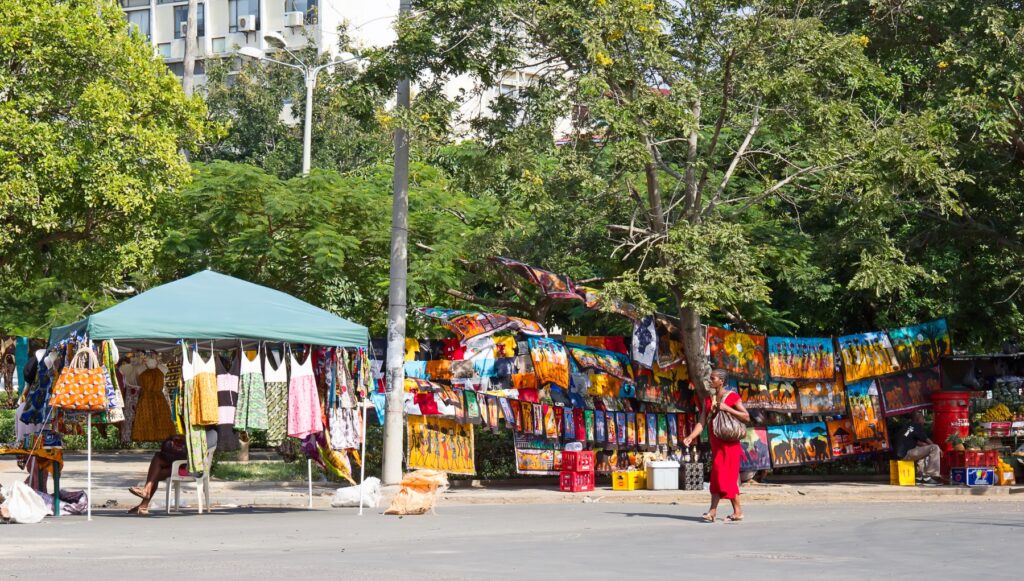
If you like tumbledown buildings then there’s a gorgeous old colonial house called Vila Algarve on the corner of Avenida Ahmed Sékou Touré and Avenida dos Mártires da Machava (next door to the Hotel Terminus; page 102). Covered in intricate mosaics, it’s a beautiful building, though your admiration may be tempered by the realisation that it was the centre for the security police in latter colonial times, and a byword for torture and murder. It’s listed for restoration, as it has been for at least ten years so, for now, you’ll have to be content with views from the outside.
The Baixa
The best place to begin a walking tour of the city centre is at the intersection of Avenida 25 de Setembro and Avenida Samora Machel, with the Café Continental on one corner and the Cinema Scala, built in 1931, on the other. Start by walking down Avenida 25 de Setembro in a westerly direction (towards the railway station).
After the next street to the right (Avenida Karl Marx) you reach the Mercado Central. The surrounding streets have several Asian-owned shops with a decent selection of imported hardware items (flashlights, electronic gadgets, tools, etc). Continue along Avenida 25 de Setembro and walk down Avenida Guerra Popular, which brings you to the Praça dos Trabalhadores, at the centre of which lies a large, brazenly patriotic memorial to the Portuguese soldiers killed in World War I, topped by a muscular statue of a woman representing the Patria, the ‘Fatherland’.
On the western side of the square is the palatial green-and-white Railway Station (Estação de Trem), built in 1910 following a design by the architect Gustave Eiffel (of Eiffel Tower fame) and notable for its plethora of marble pillars and wrought-iron detail. Once the terminus of the most important railway line in southern Africa, the shortest coastal connection from the industrial areas and gold mines of the Witwatersrand and Johannesburg and the mines of southern Zimbabwe, the opulent, Victorian-style station is little used these days, but magnificently restored in 2016, enhancing its importance as one of Maputo’s top architectural monuments. Today it is frequently rated as one of the world’s ten most impressive railway stations, and now also houses the Museu do CFM railway museum, also well worth a browse.
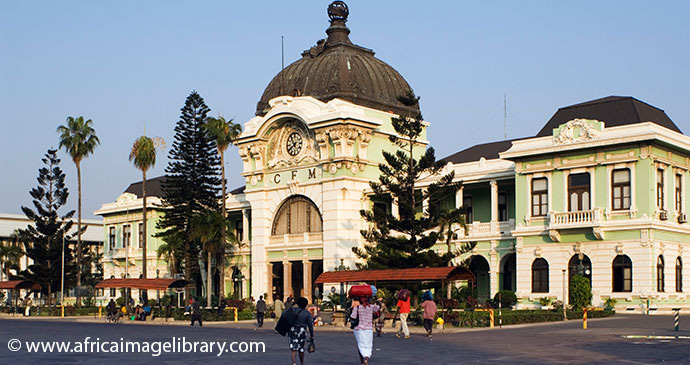
Close to the railway station lies the entrance to the harbour. During colonial times, Maputo harbour was more important to southern Africa than even Durban, a status it seems unlikely to reclaim in the foreseeable future. From the quay, with its huge cranes, there is a view of the ships anchored in the Bay of Maputo.
Between the station forecourt and Avenida Samora Machel is the Old Town. Most of the buildings constructed in the late 19th century are quite run-down but they still have a certain charm. Many are still graced by wood or iron filigree and covered balconies, reminiscent of the Creole style of Mauritius and Réunion, and a few have been restored in recent years. It’s worth poking around these streets, taking in the variety of buildings, and in particular having a look at the Jumma Masjid, a large, well-kept and much-frequented mosque.
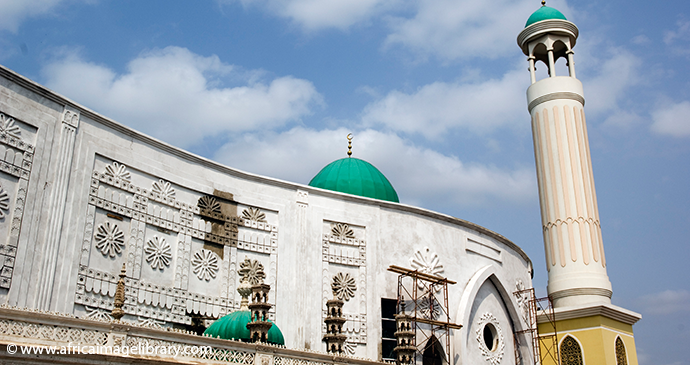
East of the station, Rua do Bagamoyo – formerly known as the ‘Street of Trouble’ by sailors who frequented its many bars – is still not the most peaceful or salubrious of places. Indeed, it pretty much serves as Maputo’s red light district, with its numerous down-at-heel bars and strip clubs, though there is little evidence of this in daylight hours. Rua do Bagamoyo terminates at the Praça dos 25 de Junho, where you’ll find the Fortaleza da Nossa Senhora da Conceição and Museu Nacional da Moeda keeping each other company on either side of the square.
Immediately opposite the fort is the Ministério da Indústria e Comércio, a large Stalinesque concrete slab topped by a bizarre tower that seems to have been based on a German alpine castle, creating a freakish architectural blend of Brutalism with Disneyesque fantasy. Some of the fort’s cannons are pointing directly at it, as if they were waiting to put it out of its misery.
Across the street from the money museum is the Banco de Moçambique with a colourful glass-and-steel frontage. Take the street heading north behind the bank to Avenida 25 de Setembro and walk back towards the crossroads with Avenida Samora Machel, then turn left towards the Jardim Tunduru (Botanical Gardens), a public park with many large shady trees, a few statues, lily ponds and a hothouse (sometimes closed); free entry. It’s only small but particularly pleasant towards the end of the day as the lowering sun casts yellowing stripes on the grass.
To the left of the main entrance gate, on the Praça de Independência, is a huge statue of Samora Machel, the country’s first president. Donated by Kim Il-Sung of North Korea, the statue of Machel bears a strange and inaccurate resemblance to Chairman Mao. Just up from there is the Casa de Ferro, a construction of prefabricated metal parts designed by the French engineer Eiffel. Opposite, on the east side of the Tunduru gardens, is the palace in which Paul Kruger, President of the South African Republic, resided after fleeing from British troops at the end of the 19th century. This old building now houses the Centre Culturel Franco-Mozambicain, which has a pleasant semi-outdoor café, regular art exhibitions and a funky little shop selling locally made handicrafts and clothing.
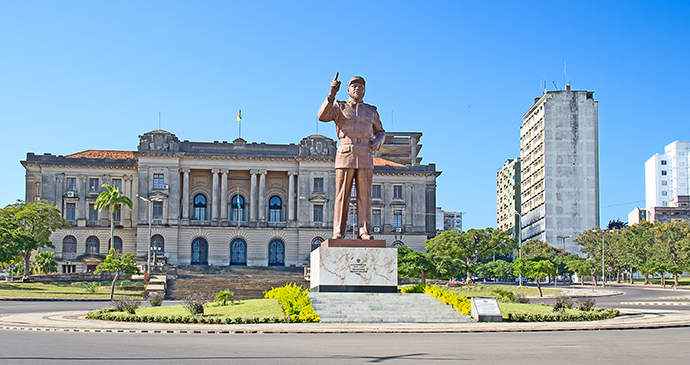
Continuing up Avenida Samora Machel brings you to the imposing town hall and yet another statue of Samora Machel; this one is the largest in the country, replacing the rather smaller equestrian statue of the Portuguese former governor of Mozambique, Joaquim Mouzinho de Albuquerque, now installed in the Fortaleza da Nossa Senhora da Conceição.
On its right is the glistening white Catholic cathedral, a soaring structure that was completed in 1944. From the cathedral, cross the Praça de Independência and walk along Avenida Josina Machel for a block and a half. On the southern side of the road is perhaps the most surprising monument in the Baixa, the Louis Trichardt Memorial Garden, which lies on Avenida Josina Machel immediately west of Avenida Karl Marx, and is worth seeing if only because it is so incongruous. Finish off your walk by going back along Avenida Josina Machel to the Praça de Independência, and put your feet up at the Centre Culturel Franco-Mozambicain with a cold beer and a perfect spot to watch passers-by in the twilight.
More information
For more information, see Philip Briggs’s guide:
